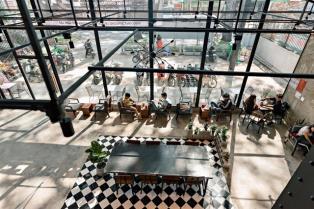Huge investments in housing by the Overseas Vietnamese community have helped the market pick up steam.
 |
| A conner of Ho Chi Minh City. — File Photo |
by Le Hung Vong
Huge investments in housing by the Overseas Vietnamese community have helped the market pick up steam.
Le Hoa My of HCM City's District 10 said her husband, who works for a wood processing company in China, remits home some $30,000 annually. Seeing that interest rates on dong deposits have gone down sharply, My withdrew VND1 billion to buy 200sq.m of land in Cu Chi District.
"The price of this plot of land has gone up from VND800 million two years ago to VND1 billion now," she said.
"I'll sell it in future for some profit."
A manager at a remittance company in HCM City told Sai Gon Giai Phong (Liberated Saigon) newspaper that remittances sent to HCM City in the first five months of this year amounted to US$1.7 billion.
He said the revival of the housing sector could result in more remittances, which are expected to reach $5.3 billion this year, about half a billion dollars more than last year.
The manager of the remittance firm said in the past customers used to sell the dollar remittance they got, convert into dong and deposit the money in banks. But now, with interest rates on dong and dollar deposits down, many Overseas Vietnamese invested in the real estate market, he said.
Through banks, overseas Vietnamese clients directly pay for property they buy at new housing projects.
With easier and simplier formalities and the Government allowing overseas Vietnamese to buy houses in Viet Nam, the housing market is expected to see more remittances from the overseas community flow in.
Nguyen Hoang Minh, deputy director of the State Bank of Viet Nam's HCM City office, said there had been a makeover in terms of choosing asset classes, with a higher proportion of remittances being invested in the real estate and business sectors since 2014.
"Remittances channelled into housing are expected to rise further in the second half of this year," he said.
"The growth rate of 21.2 per cent in terms of investments in the real estate sector in 2014 is expected to rise to 23-24 per cent this year. Most of the amount invested [in housing] has been in projects now under construction."
Airport expansion
Da Nang International Airport must be expanded to meet an upsurge in international arrivals, according to a report sent recently by the Airports Corporation of Viet Nam (ACV) to the Ministry of Transport.
As the third largest international airport in Viet Nam, Da Nang will be overloaded in the coming years if it is not expanded soon, it says.
The report notes that the number of passengers using the Airport has risen by 14 per cent annually in recent years. In 2014 it served five million passengers - a year-on-year increase of 16 per cent — including over 900,000 international visitors (up 53 per cent).
The number is forecast to reach 6 million in 2016, over 9 million in 2020 and 20 million in 2030, the ACV says.
Le Manh Hung, general director of the ACV, says the number of passengers using Da Nang Airport might rise to 6-8 million a year from 2015.
"The airport will certainly be overloaded in the next few years if the number of passengers going through the airport continues to grow as strongly as in previous years."
Therefore, building one more terminal is a must, he says.
Construction of a new 40,000sq.m terminal is indeed slated to begin early next year. The new facility will enable the airport to have separate terminals for domestic and international services. It will have separate arrival and departure floors, 40 check-in counters, nine boarding gates, four aerobridges and five baggage conveyor belts.
ACV estimates the expansion will cost VND3.2 trillion (over $147 million), including VND300 billion for land.
The new terminal is expected to be completed in June 2017, four months ahead of the APEC summit in Da Nang.
The existing 36,600sq.m terminal at the airport was built in December 2011 at a cost of over VND1.3 trillion, and it can handle up to 6 million passengers a year.
Da Nang Airport is served by three local airlines and 10 foreign carriers offering both scheduled and chartered flights, and handles 140 take-offs and landings every day.
Room rates slashed
Many hotels in popular tourist spots like Phan Thiet, Nha Trang and Da Lat have slashed room rents though the summer holiday season has just started, with a sharp increase in supply being cited as the reason for the cuts.
In Phan Thiet, this year holidaymakers can pay VND1.4– VND1.5 million (around US$80) for one night at four-star properties like Mui Ne Bay Resort.
Other resorts in Ham Tien Village also offer lower room rents compared to last year.
Nguyen Van Khoa, chairman of the Binh Thuan Tourism Association, was quoted by Sai Gon Marketing newspaper as saying that with hotels and resorts mushrooming in Phan Thiet, owners have had to lower prices to remain competitive. Room rates have gone down by an average of 20 per cent.
Resorts in Phan Thiet have also had to cut rates because the city itself faces increasing competition from other coastal places like Nha Trang and Phu Quoc Island.
Binh Thuan Province adds nearly 2,000 new rooms every year.
Travellers to Nha Trang are getting a warmer welcome these days as the decline in Russian tourist numbers has forced hotels and resorts to cut rents by 10 per cent and focus on serving other nationals. Khanh Hoa Province has around 18,000 hotel rooms, mostly in Nha Trang.
Visitors to Da Lat can get a four-star room for VND1 million a night, VND200,000 - 300,000 lower than at the same time last year.
"Tours to Da Lat are less attractive to [local] travellers because they have no new destinations there," Nguyen Ngoc An, manager of Fiditour's local tour segment, said.
Hotels in Hue are offering rooms for VND550,000-600,000 to travel firms. Four-star hotels charge guests VND900,000 to VND1 million per night, only half the rates they have to pay in HCM City.
On the other hand, travel firms have seen room rates go up in Da Nang and Phu Quoc.
Although most hotels in Da Nang have reported high occupancy rates in the past months, room rates are not too higher compared with last year.
Trave firms have said they found it difficult to get rooms at popular beachside hotels in Da Nang since these places are attracting large groups of visitors from northern provinces and North-east Asia. Da Nang tourism authorities say the city welcomes some 11,000 Korean visitors a month.
Tariffs at two- and three-star hotels in Phu Quoc have risen from VND1.2 – VND1.3 million per night last summer to VND1.5 million now.
Last year hotel owners in Phu Quoc had claimed that their room rates were higher than in other tourist destinations around the country because they had to pay higher costs, including for electricity since the island was then powered by diesel generators.
"But now when Phu Quoc has been connected with the national power grid, hotels keep increasing room rates instead of offering cuts," a HCM City hotel executive told your columnist.
According to the Viet Nam Tourist Association, as of last December Viet Nam had 16,000 hotels, resorts and guesthouses with 332,000 rooms. These included 75 five-star, 191 four-star, 381 three-star, 1,180 two-star, and 2,460 one-star hotels. — VNS.





